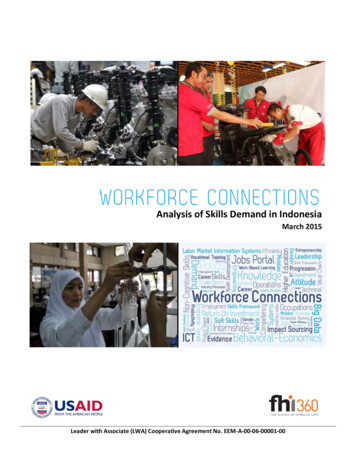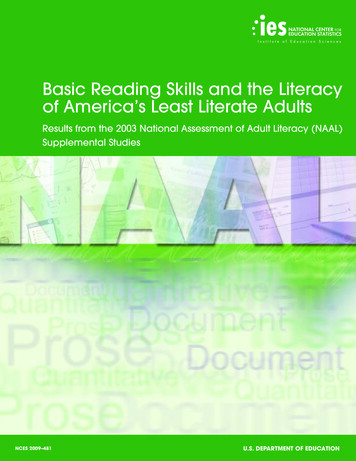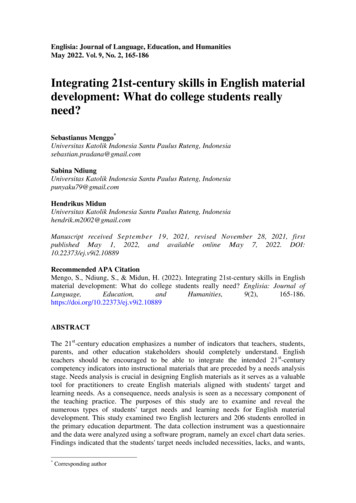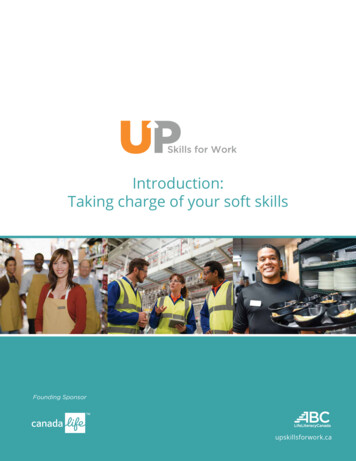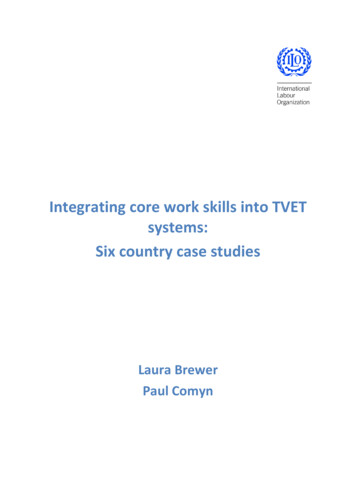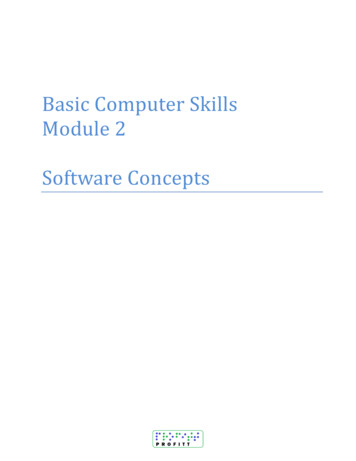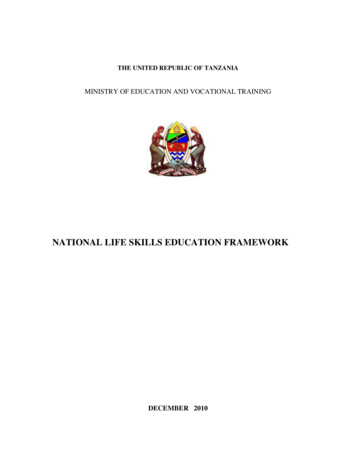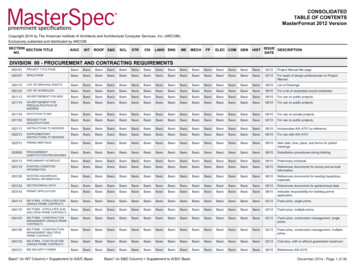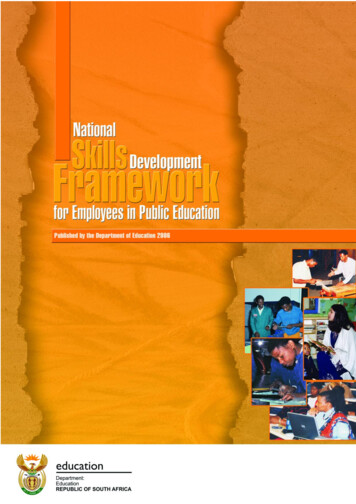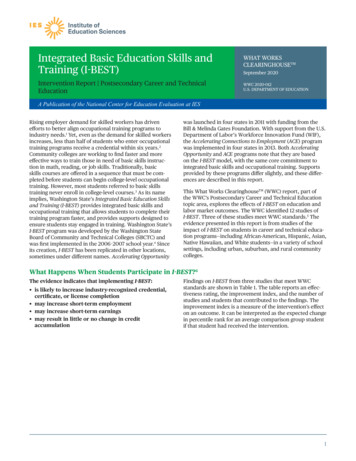
Transcription
Integrated Basic Education Skills andTraining (I-BEST)Intervention Report Postsecondary Career and TechnicalEducationWHAT WORKSCLEARINGHOUSETMSeptember 2020WWC 2020-012U.S. DEPARTMENT OF EDUCATIONA Publication of the National Center for Education Evaluation at IESRising employer demand for skilled workers has drivenefforts to better align occupational training programs toindustry needs.1 Yet, even as the demand for skilled workersincreases, less than half of students who enter occupationaltraining programs receive a credential within six years.2Community colleges are working to find faster and moreeffective ways to train those in need of basic skills instruction in math, reading, or job skills. Traditionally, basicskills courses are offered in a sequence that must be completed before students can begin college-level occupationaltraining. However, most students referred to basic skillstraining never enroll in college-level courses.3 As its nameimplies, Washington State’s Integrated Basic Education Skillsand Training (I-BEST) provides integrated basic skills andoccupational training that allows students to complete theirtraining program faster, and provides supports designed toensure students stay engaged in training. Washington State’sI-BEST program was developed by the Washington StateBoard of Community and Technical Colleges (SBCTC) andwas first implemented in the 2006–2007 school year.4 Sinceits creation, I-BEST has been replicated in other locations,sometimes under different names. Accelerating Opportunitywas launched in four states in 2011 with funding from theBill & Melinda Gates Foundation. With support from the U.S.Department of Labor’s Workforce Innovation Fund (WIF),the Accelerating Connections to Employment (ACE) programwas implemented in four states in 2013. Both AcceleratingOpportunity and ACE programs note that they are basedon the I-BEST model, with the same core commitment tointegrated basic skills and occupational training. Supportsprovided by these programs differ slightly, and these differences are described in this report.This What Works ClearinghouseTM (WWC) report, part ofthe WWC’s Postsecondary Career and Technical Educationtopic area, explores the effects of I-BEST on education andlabor market outcomes. The WWC identified 12 studies ofI-BEST. Three of these studies meet WWC standards.5 Theevidence presented in this report is from studies of theimpact of I-BEST on students in career and technical education programs—including African-American, Hispanic, Asian,Native Hawaiian, and White students—in a variety of schoolsettings, including urban, suburban, and rural communitycolleges.What Happens When Students Participate in I-BEST?6The evidence indicates that implementing I-BEST: is likely to increase industry-recognized credential,certificate, or license completion may increase short-term employment may increase short-term earnings may result in little or no change in creditaccumulationFindings on I-BEST from three studies that meet WWCstandards are shown in Table 1. The table reports an effectiveness rating, the improvement index, and the number ofstudies and students that contributed to the findings. Theimprovement index is a measure of the intervention’s effecton an outcome. It can be interpreted as the expected changein percentile rank for an average comparison group studentif that student had received the intervention.1
Table 1. Summary of findings on I-BEST from studies that meet WWC StandardsStudy findingsEvidence meeting WWC standards (version 4.0)Improvement index(percentile points)Number of studiesNumber of studentsPositive effects 18344,367Potentially positive effects 1012,064Outcome domainEffectiveness ratingIndustry-recognized credential,certificate, or license completionShort-term employmentShort-term earningsPotentially positive effects022,519Credit accumulationNo discernible effects-1142,894Note:The improvement index can be interpreted as the expected change in percentile rank for an average comparison group student if that student had received theintervention. For example, an improvement index of 18 means that the expected percentile rank of the average comparison group student would increase by 18 points if thestudent received I-BEST. The improvement index values are generated by averaging findings from the outcome analyses that meet WWC standards, as reported by Glosseret al. (2018), Modicamore et al. (2017), and Anderson et al. (2017). A positive improvement index does not necessarily mean the estimated effect is statistically significant.Industry-recognized credential, certificate, or license completion outcomes reported in these studies include receipt of a credential from any source; receipt of a vocational,technical, or professional license or certificate; and receipt of any credential from a college. The short-term employment outcome reported in one study was employed inthe first year after program completion. Short-term earnings outcomes included working in a job paying 12 or more after 18 months and earnings one year after programcompletion. The credit accumulation outcome was the percentage of students earning more than 12 credits. The effects of I-BEST are not known for other outcomes withinthe Postsecondary Career and Technical Education topic area, including technical skill proficiency, postsecondary degree attainment, medium-term employment, long-termemployment, medium-term earnings, and long-term earnings.BOX 1. HOW THE WWC REVIEWS AND DESCRIBES EVIDENCEThe WWC evaluates evidence based on the quality and results of reviewed studies. The criteria the WWC uses for evaluatingevidence are defined in the Procedures and Standards Handbooks and the Review Protocols. The studies summarized in this reportwere reviewed under WWC Standards (version 4.0) and the Postsecondary Career and Technical Education topic area protocol(version 4.0).To determine the effectiveness rating, the WWC considers what methods each study used, the direction of the effects, and thenumber of studies that tested the intervention. The higher the effectiveness rating, the more certain the WWC is about the reportedresults and about what will happen if the same intervention is implemented again. The following key explains the relationshipbetween effectiveness ratings and the statements used in this report:Effectiveness ratingRating interpretationDescription of the evidencePositive (or negative) effectsThe intervention is likely to change anoutcomeStrong evidence of a positive effect, with nooverriding contrary evidencePotentially positive (or negative) effectsThe intervention may change an outcomeEvidence of a positive effect with no overridingcontrary evidenceNo discernible effectsThe intervention may result in little to nochange in an outcomeNo affirmative evidence of effectsMixed effectsThe intervention has inconsistent effectson an outcomeEvidence includes studies in at least two ofthese categories: studies with positive effects,studies with negative effects, or more studieswith indeterminate effects than with positive ornegative effectsHow is I-BEST Implemented?The following section provides details of how I-BEST wasimplemented. This information can help educators identifythe requirements for implementing I-BEST and determinewhether implementing this intervention would be feasiblein their colleges. Information on I-BEST presented in thissection comes from the studies that meet WWC standards(Glosser et al., 2018; Modicamore et al., 2017; and Andersonet al., 2017) and from correspondence with the developer.Comparison group: In the three studies thatcontribute to this intervention report, students inthe comparison group received the regular supportsprovided by their community college. In the ACEstudy (Modicamore et al., 2017), students who enteredthe program through a WIB had access to regular WIBservices which included training referrals, careercounseling, and job search assistance.2
Goal: I-BEST was developed by SBCTC to increase therate at which adults in need of basic skills enter andsucceed in postsecondary occupational training. It isdesigned to integrate adult basic education and occupational skills training, so students can learn literacy,math, work, and college-readiness skills and move intoliving wage jobs faster. It provides an alternative to thetraditional track of providing adult basic educationprior to students entering occupational training, whichgenerally results in low rates of advancement betweenbasic skills and occupational training. Target population: I-BEST allows individuals with skilllevels that are lower than normally required to enroll incollege-level programs to pursue credit-bearing, shortterm certificate programs as well as college degrees. Method of delivery: I-BEST’s signature feature is itsteam teaching approach, which involves a basic skillsinstructor and an occupational instructor co-teachingduring at least 50 percent of occupational training classtime. The Accelerating Opportunity model calls for aminimum of 25 percent team teaching, while the ACEmodel prescribes a 50 percent minimum of team teaching. In addition, a dedicated I-BEST navigator (coach) isavailable to students who can provide career counselingand help students access “fill-the-gap” financial supportfor tuition and course materials; funding for supportservices (e.g., uniforms, transportation, licensuretesting); clinical placements (for nursing students); andinternships. Both Accelerating Opportunity and ACE hadpartnerships with Workforce Investment Boards (WIBs)that connected students to employers. Frequency and duration of service: Some I-BESTprograms require full-time enrollment while othersare offered part-time in the evenings or weekends. Theduration of students’ participation in I-BEST dependson their course of study. For example, as reported inGlosser et al. (2018), automotive, electrical, and certifiednursing assistant trainings lasted one quarter while precision machining, welding, and sustainable office skillstrainings lasted two quarters. Intervention components: Refer to Table 2 for additional details.Table 2. Components of I-BESTKey componentDescriptionTeam teachingI-BEST offers students integrated basic skills and occupational skills training. Both the basic skills instructor and the occupationaltraining instructor are required to be present in class for at least half of the total instructional time in an I-BEST course—or 25 percentof total instructional time in Accelerating Opportunity. Instructors collaborate to identify joint learning outcomes for students in theirclass and both take part in leading discussions and managing student projects. Team teaching can take on different forms: Complementary-supportive teaching, where one teacher is responsible for teaching content and the other is responsible forproviding follow-up activities or study skills. Parallel instruction, where the class is divided into two groups and each teacher is responsible for teaching the same material toeach group. Differentiated split class, where the class is divided into smaller groups according to learning needs, and each teacher providesinstruction to their respective group. Monitoring teacher, where one teacher instructs the entire class and the other teacher circulates in the classroom and monitorsstudent understanding and behavior.In the Accelerating Opportunity evaluation (Anderson et al., 2017), all six types of team teaching models were used, with thecomplementary-supportive model being most popular, followed by monitoring teacher, traditional, and collaborative. In the ACE study(Modicamore et al., 2017), the complementary-supportive model was described as being typical. In the I-BEST study (Glosser et al.,2018), collaborative teaching was implemented, as were two variants of traditional team teaching: (1) basic skills instructors deliveredinstruction for part of the class period, then turned over instruction to the occupational skills instructor, and (2) both instructorsdelivered class content together.I-BEST uses a contextualized instruction approach, where students learn basic skills in the context of their course of study. Forexample, in an I-BEST nursing program, increased emphasis is placed on learning medical terms in addition to mastering everydayvocabulary. This instructional model aims to improve the motivation and achievement of students by providing them experienceswhere they can see the usefulness of basic skills instruction in their chosen field.CareernavigationI-BEST provides students with a career navigator, who provides intake, orientation, job readiness, mentoring, and job placementservices. I-BEST offers multiple tracks from its traditional program, to either provide additional vocational education that can lead to acollege degree, or provide additional academic instruction to help students advance on a career pathway.FinancialsupportsI-BEST students in Washington can receive Opportunity Grants when they enroll in I-BEST professional technical pathways. Thegrant covers up to 45 credits of tuition and up to 1,000 a year for books and supplies.AdditionalsupportsI-BEST students also receive tutoring, career advising, emergency child care, emergency transportation, and college successclasses.Job placementassistanceBoth the Accelerating Opportunity and ACE implementation of the I-BEST model included partnerships with local WIBs to placestudents in jobs. I-BEST as studied in Glosser et al. (2018) did not include specific employment and job placement services.3
What Does I-BEST Cost?This preliminary list of costs is not designed to beexhaustive; rather, it provides educators with an overviewof the major resources needed to implement I-BEST. Theprogram costs described below are based on informationavailable as of March 2020. The total cost of I-BEST wasreported in a SBCTC cost-benefit analysis to be 2,417 indirect student costs and 7,279 in state costs as of January2013. The total cost of ACE as of May 2017 ranged from 4,828 to 13,033 per student across the nine sites. The totalcost of Accelerating Opportunity as of November 2017 rangedfrom 2,635 to 7,128 per student across four states. Below isa breakdown of the costs reported in the SBCTC study. Facilities costs: No additional facilities costs werereported beyond the facilities costs normally associatedwith college attendance. Equipment and materials costs: The SBCTC costbenefit analysis reported that enrollment support, whichincludes both direct and indirect costs of instruction, was 4,396 per I-BEST completer. Washington State providedan average of 2,883 in financial aid support per I-BESTcompleter. In-kind supports: I-BEST students also receive tutoring,career advising, emergency child care, emergencytransportation, and college success classes. Personnel costs: The SBCTC cost-benefit analysisreported that enrollment support, which includes bothdirect and indirect costs of instruction, was 4,396 perI-BEST completer. Costs paid by students or parents: The SBCTC costbenefit analysis reported that tuition minus the weightedaverage financial aid per student completer was 1,114.The cost of books was listed as 1,000 and the cost offees was 300 per student completer. Students canuse Opportunity Grants when they enroll in I-BESTprofessional technical pathways, which cover up to 45credits of tuition and up to 1,000 a year for books andsupplies. Sources of funding: I-BEST is funded by SBCTC. TheAccelerating Opportunity program was funded by the Bill &Melinda Gates Foundation. The ACE program was fundedthrough a U.S. Department of Labor Workforce InnovationFund grant with additional support from the Annie E.Casey Foundation.For More Information:About I-BESTWashington SBCTC1300 Quince St SE, 4th floorOlympia, WA 98504-2495Attn: William Durden, Policy Associate, Basic Education for AdultsEmail: wdurden@sbctc.edu Web: ices/i-best/ Phone: (360) 704-4368About the cost of the interventionWeb: s/InvestmentsinI-BESTPrograms.pdfSee alsoModicamore, D., Lamb, Y., Taylor, J., Takyi-Laryea, A., Karageorge, K., & Ferroggiaro, E. (2017). Accelerating Connections toEmployment, volume 1: Final evaluation report. Fairfax, VA: ICF International.Kuehn, D., Anderson, T., Lerman, R., Eyster, L., Barnow, B., & Briggs, A. (2017). A cost-benefit analysis of Accelerating Opportunity.Washington, DC: Urban Institute. Retrieved from ion/94876/ao-cba-report.pdfResearch SummaryThe WWC identified 12 studies that investigated the effectiveness of I-BEST (Figure 1): Two studies meet WWC group design standards withoutreservations One study meets WWC group design standards withreservationsthe WWC generates an effectiveness rating, which summarizes how the intervention impacts, or changes, a particularoutcome domain. The WWC reports additional supplemental findings, such as state-by-state results for credit accumulation (Anderson et al., 2017), on the WWC website(https://whatworks.ed.gov). Six studies are ineligible for reviewThese supplemental findings and findings from studies thateither do not meet WWC standards or are ineligible forreview do not contribute to the effectiveness ratings.The WWC reviews findings on the intervention’s effects oneligible outcome domains from studies that meet standards,either with or without reservations. Based on this review,The three studies of I-BEST that meet WWC group designstandards reported findings on industry-recognized credential, certificate, or license completion; short-term Three studies do not meet WWC group design standards4
employment; short-term earnings; and credit accumulation.No other findings in the studies meet WWC group designstandards within any outcome domain included in thePostsecondary Career and Technical Education topic area.Citations for the three studies reviewed for this report arelisted in the References section, which begins on page 13.Citations for the six studies that are ineligible for review andthe reasons the WWC determined they were ineligible arealso listed in the References section.Figure 1. Effectiveness ratings for I-BESTmeet WWCmeets WWCdo not2 studies1 study3 studiesstandards withoutstandards withmeet WWCreservationsreservationsContribute to effectiveness ratingsstandardsare6 studiesineligible forreviewDo not contribute to effectiveness ratingsI-BEST has positive effects on industry-recognized credential, certificate, or license completionThe WWC determined that two studies that meet WWC group design standards without reservations(Glosser et al., 2018; Modicamore et al., 2017) and one study that meets WWC group designs standards withreservations (Anderson et al., 2017) showed evidence of a positive and statistically significant effect of I-BEST onindustry-recognized credential, certificate, or license completion.I-BEST has potentially positive effects on short-term employmentThe WWC determined that one study that meets WWC group design standards without reservations (Modicamoreet al., 2017) showed evidence of a positive and statistically significant effect of I-BEST on short-term employment.I-BEST has potentially positive effects on short-term earningsThe WWC determined that one study that meets WWC group design standards without reservations (Modicamore etal., 2017) showed evidence of a positive and statistically significant effect of I-BEST on short-term earnings, and onestudy that meets WWC group design standards without reservations (Glosser et al., 2018) showed evidence of anindeterminate effect of I-BEST on short-term earnings.I-BEST has no discernible effects on credit accumulationThe WWC determined that one study that meets WWC group designs standards with reservations showed evidence ofan indeterminate effect of I-BEST on credit accumulation (Anderson et al., 2017).Main FindingsTable 3 shows the findings from the three I-BEST studiesthat meet WWC standards. The table includes WWC calculations of the mean difference, effect size, and performanceof the intervention group relative to the comparison group.Based on findings from the three studies that meet WWCstandards, the effectiveness rating for the industry-recognized credential, certificate, or license completion domain ispositive effects, indicating strong evidence of a positive effectwith no overriding contrary evidence. These findings arebased on 44,367 students. The effectiveness rating forthe short-term employment domain is potentially positiveeffects, indicating evidence of a positive effect with nooverriding contrary evidence. This finding is based on 2,064students. The effectiveness rating for short-term earnings ispotentially positive effects, indicating evidence of a positiveeffect with no overriding contrary evidence. These findingsare based on 2,519 students. The effectiveness rating for thecredit accumulation domain is no discernible effects,indicating no affirmative evidence of effects. This finding isbased on 42,894 students.5
Table 3. Findings by outcome domain from studies of I-BEST that meet WWC StandardsMean(standard deviation)WWC calculationsStudy ved a credential from anysource (%) (Glosser et al., 2018)aFull Sample42433.518.215.30.49 19 .01Earned a vocational, technical, orprofessional certificate or license(%) (Modicamore et al., 2017)bFull Sample1,04953.535.418.10.45 17 .01Received any credential froma college (%) (Anderson et al,2017)cFull Sample42,89452.633.019.60.49 19 .01Outcome average for industry-recognized credential, certificate, or license completion across all studies0.48 18Employed in the first yearafter program completion (%)(Modicamore et al., 2017)b0.27 100.27 10Measure (study)Full Sample2,06462.651.910.7Outcome average for short-term employment across all studies .01Working in a job paying 12 anhour or more (%) (Glosser et al.,2018)aFull Sample45523.023.8-0.8-0.03-1.85Earnings one year after program(Modicamore et al., 2017)bMaryland andTexas Sample1,513 12,897.00 11,601.80 1,295.200.13 5 .01Earnings one year after program(Modicamore et al., 2017)bConnecticutSample348 14,125.19 12,578.79 1,546.400.15 6.12Earnings one year after program(Modicamore et al., 2017)bGeorgiaSample203 5,783.50 7,154.60- 1,371.10-0.22-9.0800-0.03-1-0.03-1Outcome average for short-term earnings across all studiesEarned more than 12 credits (%)(Anderson et al., 2017)cFull Sample42,894Outcome average for credit accumulation across all studies45.746.9-1.2.13Notes: For mean difference and effect size values reported in the table, a positive number favors the intervention group and a negative number favors the comparison group.The effect size is a standardized measure of the effect of an intervention on outcomes, representing the average change expected for all individuals who are given theintervention (measured in standard deviations of the outcome measure). An indicator of the effect of the intervention, the improvement index can be interpreted as the expectedchange in percentile rank for an average comparison group student if that student had received the intervention. For example, an improvement index of 4 means that theexpected percentile rank of the average comparison group student would increase by 4 points if the student received I-BEST. A positive improvement index does notnecessarily mean the estimated effect is statistically significant. Some statistics may not sum as expected due to rounding.a Glosser et al. (2018) did not require corrections for clustering or multiple comparisons nor difference-in-differences adjustments. Findings from the 18-month follow-up survey,with imputed cases removed, were presented by the author in response to a WWC author query. The p-value for receipt of a credential from any source was calculated by theWWC since the author provided the results of a one-tailed test. This study is characterized as having a statistically significant positive effect on industry-recognized credential,certificate, or license completion because the estimated effect is positive and statistically significant. The study is characterized as having an indeterminate effect on short-termearnings because the estimated effect reported is not statistically significant.b Modicamore et al. (2017) did not require corrections for clustering nor difference-in-differences adjustments. A correction for multiple comparisons was needed but did notaffect whether any of the contrasts were found to be statistically significant. The p-value for employment in the first year after program completion was not presented in theoriginal study and was calculated by the WWC. Authors did not report standard deviations of earnings outcomes; however, they did report the effect size using the Hedges’g formula and conducted a Benjamini-Hochberg correction for multiple comparisons. This study is characterized as having a statistically significant positive effect on (a)industry-recognized credential, certificate, or license completion, (b) short-term employment, and (c) short-term earnings because the estimated effect is positive and statisticallysignificant.c Anderson et al. (2017) did not require corrections for clustering or multiple comparisons nor difference-in-differences adjustments. The outcomes for earning any credentialfrom a college and earning more than 12 credits were aggregated across subsamples by the WWC, and the p-values for these outcomes were calculated by the WWC basedon the aggregated sample. This study is characterized as having a statistically significant positive effect on industry-recognized credential, certificate, or license completionbecause the estimated effect is positive and statistically significant. This study is characterized as having an indeterminate effects on credit accumulation because the estimatedeffect is not statistically significant.For more information, please refer to the WWC Procedures Handbook, version 4.0, page 22.6
In What Context Was I-BEST Studied?The following section provides information on the setting ofthe three studies of I-BEST that meet WWC standards, and adescription of the participants in the research. Thisinformation can help educators understand the context inwhich the studies of I-BEST were conducted, and determinewhether the program might be suitable for their setting.WHERE THE STUDY WAS CONDUCTED3 studies, 45,413 students in Connecticut, Georgia, Illinois,Kansas, Kentucky, Louisiana, Maryland, Texas, and WashingtonDistricts: Urban, suburban, and rural settingsRace 21%60%19%AfricanWhiteAmericanOtherGender 57%FemaleEthnicity condaryMaleDetails of Each Study that Meets WWC StandardsThis section presents details for the studies of I-BEST thatmeet WWC standards. These details include the full studyreference, findings description, findings summary, anddescription of study characteristics. A summary of domainfindings for each study is presented below, followed by adescription of the study characteristics. These study-leveldetails include contextual information about the studysetting, methods, sample, intervention group, comparisongroup, outcomes, and implementation details. For additional information, readers should refer to the originalstudies.Training (I-BEST) Program in three colleges: Implementation and early impact report (OPRE Report No. 2018-87).Washington, DC: Office of Planning, Research, and Evaluation, Administration for Children and Families, U.S.Department of Health and Human Services.Findings from Glosser et al. (2018) show evidence of astatistically significant positive effect of I-BEST industry-recognized credential, certificate, or license completion. Thestudy showed evidence of an indeterminate effect on shortterm earnings (Table 4). These findings are based on anoutcome analysis that includes 455 students.Research details for Glosser et al. (2018)Glosser, A., Martinson, K., Cho, S. W., & Gardiner, K. (2018).Washington State’s Integrated Basic Education and SkillsTable 4. Summary of findings from Glosser et al. (2018)Meets WWC group design standards without reservationsStudy findingsSamplesizeAverageeffect ry-recognized credential, certificate, orlicense completion424 students0.49 19YesShort-term earnings455 students-0.03-1NoOutcome domain7
Table 5. Description of study characteristics for Glosser et al. (2018)WWC evidenceratingMeets WWC Group Design Standards Without Reservations. This is a randomized controlled trial (RCT) with lowattrition.7 For more information on how the WWC assigns study ratings, please see the WWC Procedures and StandardsHandbooks (version 4.0) and WWC Standards Briefs, available on the WWC website.SettingThe study took place at three public community colleges in Washington state: Bellingham Technical College, EverettCommunity College, and Whatcom Community College.MethodsI-BEST program applicants first took the Comprehensive Adult Student Assessment System (CASAS) math and readingassessment. Students with CASAS scores within the eligibility range of their desired program then met with I-BEST staff toconfirm their interest and address program-specific requirements, such as tuberculosis screening for applicants to nursingassistant programs. Students who consented to be in the study were then given a baseline questionnaire, completed abaseline information form, and were randomly assigned by an online system to either receive I-BEST or to serve in acomparison group. Altogether, 632 study participants were randomly assigned to intervention or comparison conditionsbetween November 2011 and September 2014. The baseline sample included 315 students in the intervention group and317 students in the comparison
training program faster, and provides supports designed to ensure students stay engaged in training. Washington State's . I-BEST. program was developed by the Washington State Board of Community and Technical Colleges (SBCTC) and was first implemented in the 2006-2007 school year. 4. Since its creation, I-BEST. has been replicated in other .

